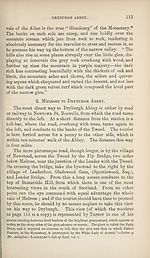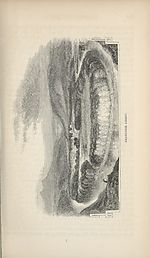Download files
Complete book:
Individual page:
Thumbnail gallery: Grid view | List view

114
EXCURSIONS PROM MELROSE.
illustrations to the Poetical Works of Sir Walter Scott. In
the immediate vicinity is Prygrange House (John Tod, Esq.),
beautifully situated. About a mile and a half from Dry grange
is the house of Cowdenknowes (Dr. Home), standing on the east
bank of the Leader, at the foot of the hill of Cowdenknowes,
celebrated in song for its “ bonny, bonny broom.” A mile
further up the Leader is the village of Earlstoun, anciently
Erceldoune, the dwelling of Thomas Learmont, commonly called
Thomas the Rhymer, in whom, as in the mighty men of old,
“the honour’d name
Of prophet and of poet was the same.”
The remains of the Rhymer’s Tower are still pointed out, in
the midst of a haugh, on the east side of the Leader. A little
further on, in the vicinity of Dryburgh, are the modern mansion
and old tower of Bemerside, the lands and barony of which have
been in the possession of the Haigs since the time of Malcolm
IV. The following rhyme respecting this family is ascribed, to
Thomas the Rhymer, whose patrimonial territory was not far
from Bemerside—
“ Tide, tide, whate’er betide,
There’ll aye be Haigs in Bemerside”—
testifying to the confident belief of the country people in the
perpetual lineal succession of the Haigs. Opposite the house
there is a Spanish chestnut tree of extraordinary age and size.
Dryburgh Abbey stands on a richly wooded haugh, round
which the River Tweed makes a circuitous sweep.* The situation
is eminently beautiful, and both the Abbey and the modern man¬
sion-house are embosomed in wood. The best view of the ruins
is from the “ Braeheads,” behind the village of Lessuden. Dry¬
burgh Abbey was founded in 1150, during the reign of David
I., by Hugh de Moreville, Lord of Lauderdale, Constable of
Scotland, upon a site which is supposed to have been originally
a place of Druidical worship. The monks were of the Premon-
stratensian order, and were brought from the Abbey founded
at Alnwick a short time before. Edward II., in his retreat from
the unsuccessful invasion of Scotland in 1322, encamped in the
grounds of Dryburgh, and, setting fire to the monastery, burnt
it to the ground. Robert I. contributed liberally towards its
The guide lives in a cottage near the entrance. The usual gratuity is Is. for
parties not exceeding six.
EXCURSIONS PROM MELROSE.
illustrations to the Poetical Works of Sir Walter Scott. In
the immediate vicinity is Prygrange House (John Tod, Esq.),
beautifully situated. About a mile and a half from Dry grange
is the house of Cowdenknowes (Dr. Home), standing on the east
bank of the Leader, at the foot of the hill of Cowdenknowes,
celebrated in song for its “ bonny, bonny broom.” A mile
further up the Leader is the village of Earlstoun, anciently
Erceldoune, the dwelling of Thomas Learmont, commonly called
Thomas the Rhymer, in whom, as in the mighty men of old,
“the honour’d name
Of prophet and of poet was the same.”
The remains of the Rhymer’s Tower are still pointed out, in
the midst of a haugh, on the east side of the Leader. A little
further on, in the vicinity of Dryburgh, are the modern mansion
and old tower of Bemerside, the lands and barony of which have
been in the possession of the Haigs since the time of Malcolm
IV. The following rhyme respecting this family is ascribed, to
Thomas the Rhymer, whose patrimonial territory was not far
from Bemerside—
“ Tide, tide, whate’er betide,
There’ll aye be Haigs in Bemerside”—
testifying to the confident belief of the country people in the
perpetual lineal succession of the Haigs. Opposite the house
there is a Spanish chestnut tree of extraordinary age and size.
Dryburgh Abbey stands on a richly wooded haugh, round
which the River Tweed makes a circuitous sweep.* The situation
is eminently beautiful, and both the Abbey and the modern man¬
sion-house are embosomed in wood. The best view of the ruins
is from the “ Braeheads,” behind the village of Lessuden. Dry¬
burgh Abbey was founded in 1150, during the reign of David
I., by Hugh de Moreville, Lord of Lauderdale, Constable of
Scotland, upon a site which is supposed to have been originally
a place of Druidical worship. The monks were of the Premon-
stratensian order, and were brought from the Abbey founded
at Alnwick a short time before. Edward II., in his retreat from
the unsuccessful invasion of Scotland in 1322, encamped in the
grounds of Dryburgh, and, setting fire to the monastery, burnt
it to the ground. Robert I. contributed liberally towards its
The guide lives in a cottage near the entrance. The usual gratuity is Is. for
parties not exceeding six.
Set display mode to:
![]() Universal Viewer |
Universal Viewer | ![]() Mirador |
Large image | Transcription
Mirador |
Large image | Transcription
| Antiquarian books of Scotland > Scotland/Scots > Black's picturesque tourist of Scotland > (174) |
|---|
| Permanent URL | https://digital.nls.uk/130030278 |
|---|
| Description | Thousands of printed books from the Antiquarian Books of Scotland collection which dates from 1641 to the 1980s. The collection consists of 14,800 books which were published in Scotland or have a Scottish connection, e.g. through the author, printer or owner. Subjects covered include sport, education, diseases, adventure, occupations, Jacobites, politics and religion. Among the 29 languages represented are English, Gaelic, Italian, French, Russian and Swedish. |
|---|

